|
|
|
Sort Order |
|
|
|
Items / Page
|
|
|
|
|
|
|
| Srl | Item |
| 1 |
ID:
085359
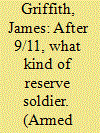

|
|
|
|
|
| Publication |
2009.
|
| Summary/Abstract |
Two concepts, Moskos's institutional-occupational orientations and Meyer and Allen's organizational commitment, were used to develop several hypotheses concerning relationships of soldiers' stated reasons for joining and staying in reserve military service to their stated career intentions and to perceived unit readiness. Survey data were obtained from first-term, junior-ranking enlisted Army National Guard soldiers nationwide at three time periods. Time periods corresponded to different phases of the Iraq conflict- before, during, and after the initial invasion. The number of soldiers at each time period equaled about 7,000 to 8,500. Results suggest material incentives may increase recruitment and retention, yet at the same time, such incentives may not enhance readiness. Rather, incentives fostering normative and affective commitments, such as joining and staying for camaraderie and service to country, were related both to self-reported career intentions and perceived unit readiness.
|
|
|
|
|
|
|
|
|
|
|
|
|
|
|
|
| 2 |
ID:
091691
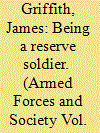

|
|
|
| 3 |
ID:
104080
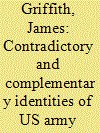

|
|
|
|
|
| Publication |
2011.
|
| Summary/Abstract |
Over the past three decades, evolving threats to U.S. national security have necessitated changes in the missions, structure, and organization of reserve forces. These changes, while intended to redefine the purposes and functions of the U.S. reserve force, at times had unanticipated effects on the individual reservist's experience of and identity with reserve military service. Emergent identities include the obliged-conscripted citizen soldier, weekend warrior, instrumental volunteer, identity seeker, soldier warrior, and conservative ideologue. The author elaborates on these identities and their association with geopolitical events and corresponding responses in the U.S. national defense strategy and concludes by discussing the implications of more recent identities for adequately staffing and readying the U.S. reserve force.
|
|
|
|
|
|
|
|
|
|
|
|
|
|
|
|
| 4 |
ID:
081059
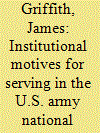

|
|
|
|
|
| Publication |
2008.
|
| Summary/Abstract |
The present study extended recent investigations of the motivations of American youth and active-duty soldiers to serve in the military. Unlike previous studies, this study employed a sample of reservists and examined their reasons for joining. Consistent with recent studies, institutionally-motivated soldiers were more likely to plan to remain in military service, would report for duty so they did not let their buddies and family down, and believed in the mission and service to the country. In contrast, materially-motivated soldiers were less likely to remain in reserve military service if deployed overseas, more likely to report for duty to meet contractual obligations and to avoid disciplinary actions, but less likely to report to serve the country. These factors have implications for the level of commitment and combat readiness of soldiers, in particular Army reservists, who are increasingly relied on for national defense strategy.
|
|
|
|
|
|
|
|
|
|
|
|
|
|
|
|
| 5 |
ID:
124061
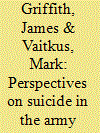

|
|
|
|
|
| Publication |
2013.
|
| Summary/Abstract |
Suicides in the US military were observed rising in 2004, most notably in the Army and Marine Corps, and particularly, in the Army National Guard (ARNG). Alarmed, Army leaders and researchers have offered various explanations and prescriptions, often lacking any evidence. In the present study, three data sets were used to examine evidence for various perspectives on suicide-dispositional risk, social cognitive, stressor-strain, and social cultural/institutional, each having different emphases on relevant explanatory variables and underlying mechanisms of suicide. Primary risk factors associated with having committed suicide among the 2007-2010 ARNG suicide cases were age (young), gender (male), and race (white), supporting the dispositional risk perspective on suicide. Some evidence supported the stressor-strain perspective in that postdeployment loss of a significant other and a major life change showed statistically significant, yet weaker associations with increased suicide intentions. Implications of results are discussed for future research and preventive strategies.
|
|
|
|
|
|
|
|
|
|
|
|
|
|
|
|
| 6 |
ID:
104075
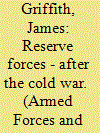

|
|
|
|
|
| Publication |
2011.
|
| Summary/Abstract |
The topic of reserve military service began with the citizen-soldier who performs military duties periodically, fending off community threats. Now, the reservist routinely performs full-time military service in support of national security operations. Evident in this shift are matters of importance, such as the preparedness of the reserve force, staffing the reserve force in its new role, the demographic and social representative-ness of the force, and so forth. Authors from different countries examine these and other issues concerning their reserve forces. Common content and themes in the articles are briefly described.
|
|
|
|
|
|
|
|
|
|
|
|
|
|
|
|
| 7 |
ID:
107664
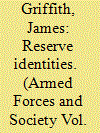

|
|
|
|
|
| Publication |
2011.
|
| Summary/Abstract |
Identities of reservists, primarily those of the U.S. military, are examined in the context of identity theory. In the current study, previously acknowledged identities of reservists are reliably measured and are shown to have construct validity. Scales were constructed from items on a previous survey of National Guard members (N = 1,256). Survey data were then used to establish scale reliability, both exploratory factor analysis and internal reliability. Scales had construct validity: Scale scores supported hypotheses derived from identity theory concerning relationships among identities, attitudes, and behavioral intentions. The importance of reserve identities to recruitment, retention, and readiness, including adaptability to deployment stressors is discussed. Identities also have implications for the broader issue of civilian-military relations.
|
|
|
|
|
|
|
|
|
|
|
|
|
|
|
|
| 8 |
ID:
181155
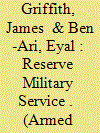

|
|
|
|
|
| Summary/Abstract |
This study examines reserve military service from a perspective of social construction—the ways in which the reservist’s conscious experiences are constructed to give meaning to military service. Content descriptions of conscious experiences of reserve military service are identified in past studies. Constructions fell into four broad categories: (1) complementary to life—reserve military service providing wanted satisfaction not otherwise achieved, material gain, or ideological commitment; (2) equitable arrangement—understood compensation for self-sacrifice; (3) discordant identity—requirements of military life blatantly or surreptitiously conflicting with established identity and civilian life; and (4) self-definition—reserve military service understood as an aspect of self-identity. Directions for integrating these constructions as a basis for future research are identified and discussed.
|
|
|
|
|
|
|
|
|
|
|
|
|
|
|
|
| 9 |
ID:
146880
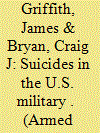

|
|
|
|
|
| Summary/Abstract |
This paper builds a case for examining suicide in the U.S. military relative to broad societal context, specifically, the unique experiences of birth cohorts relating to processes described by Durkheim’s theory of suicide. In more recent birth cohorts, suicide rates have increased among teenagers and young adults. In addition, suicide rates of age intervals at a given time period have been reliably predicted by the size of the birth cohort and the percentage of nonmarital births—supposed indicators of Durkheim’s diminished social integration and behavioral regulation. Consequences of these trends are likely more evident in the U.S. military due to having proportionally more individuals known to be at risk for suicide, that is, young males who are from nontraditional households. The all-volunteer force compared to draft force has fewer applicants to select, and proportionally more of applicants are accepted for military service. Consequently, more recruits having varied conditions now than before, perhaps including greater vulnerability to suicide, serve in the U.S. military. These points are further elaborated with supporting evidence, concluding with a call for new directions in suicide research, practice, and policy.
|
|
|
|
|
|
|
|
|
|
|
|
|
|
|
|
| 10 |
ID:
187102
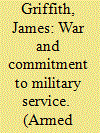

|
|
|
|
|
| Summary/Abstract |
The present study examined career intentions in two samples—home-based or garrison (N = 12,583 soldiers in 180 companies) and deployed and recently returned soldiers (N = 4,551 in 50 companies). Proportionally, fewer deployed soldiers than home-based garrison soldiers intended to stay in reserve military service. Among deployed soldiers, those who reported having experienced combat trauma, having had wounded or killed someone, and having had a friend killed in combat were less likely to plan to continue military service; reservists more likely to continue military service had returned to the same civilian job after deployment. Among deployed and garrison soldiers, fewer financial difficulties were associated with higher likelihood of continuing reserve military service. Examples from the social constructionist perspective of reserve military service are used to elaborate on mechanisms in these associations.
|
|
|
|
|
|
|
|
|
|
|
|
|
|
|
|
|
|
|
|
|